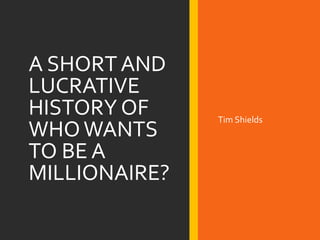
A Short and Lucrative History of Who Wants to Be a Millionaire?
- 1. A SHORT AND LUCRATIVE HISTORY OF WHOWANTS TO BE A MILLIONAIRE? Tim Shields
- 2. INTRODUCTION In his position as a director at investment bank UBS,Timothy (Tim) Shields manages information technology projects. Outside of his work at UBS, one of Stanford-educatedTim Shields’ claims to fame is being a contestant on the hit game show “WhoWants to Be a Millionaire?” “WhoWants to Be a Millionaire?” premiered on Britain’s ITV on Sept. 4, 1998. ITV cannily aired it every night for two weeks, adding 3 million viewers by the final episode. The format was geared for excitement. Continuous background music and a futuristic set provided the stage for contestants to sweat out multiple-choice questions for rising stakes. Adding to the suspense were gimmicks such as phoning a friend, blanking out two out of four possible responses, and polling the audience. “Millionaire” quickly moved to the United States, where it rocketed the American Broadcasting Company from fourth to first place. Host Regis Philbin’s playful approach, in which he pretentiously asked, “Is that your final answer?” increased the show’s popularity. In total, nine persons survived to claim the $1 million first prize. Although its prime-time success waned over the next three years, a daytime version is still in syndication, which has produced three more millionaires.The format has been adapted in multiple nations and languages. Testifying to its worldwide appeal is the 2008 film Slumdog Millionaire, about a young boy who won big in the show’s Indian version.
